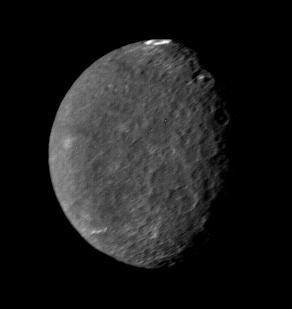
|
Umbriel :
Umbriel was officially discovered by William Lassel in 1851, at the same time as
Ariel. Like Ariel, this satellite has a composition which is
40 to 50 % ice water, the rest is rock (silicates). The colour of the surface is grey but its weak
albedo
makes it the darkest of Uranus' satellites. Umbriel's surfaced is
very cratered (like Oberon)
and has not been resurfaced since the time for the last intense bombardment that the bodies of the solar system experienced, contrary
to Ariel. |
|
Image by Voyager 2(crédit: JPL/NASA)
|
|
The image above is misleading. The bright icecap that can be seen
at the top is not a polar icecap. Indeed, it is near the equator.
It is the ring, 140 km in diameter, called Wunda and is the most reflective region on Umbriel. It could be a deposit
of shiny material due to the impact of a meteorite, but this is far from certain.
There is a second bright region by the edge of the image in the top right corner.
This is the central spike of a crater called Vuver that is 110 km wide. The weak albedo and the almost uniform colour of Umbriel could be explained in two ways. The surface could have been covered in dark material. |